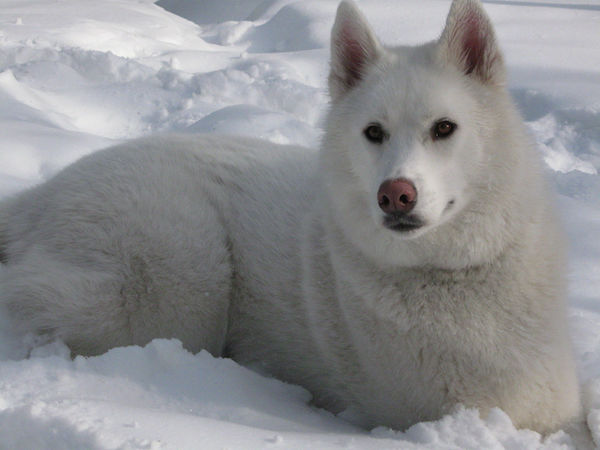
In another post, we briefly discussed the “butterfly nose,” but here we want to touch upon the “snow nose,” something many of you may be well familiar with.
During winter months, dog owners, especially those who live with light and white-coated breeds, as well as Labrador Retrievers, Siberian Huskies, Bernese Mountain Dogs and German Shepherd Dogs, will notice that their dog’s nose isn’t as black as it was even a few months before. This is called “snow nose” or “winter nose,” and is due to an enzyme called “tyrosinase” which is responsible for producing pigmentation in the nose, and which researchers used to think was more sensitive to cold temperatures. Some people even thought that snow nose in Alaskan Malamutes was due to these dogs using their noses like little shovels in the snow. Because veterinarians reported that dogs in warmer southern climates were also exhibiting snow nose, scientists came to theorize that fewer hours of sunlight during winter months is what may cause “snow nose.” A genetic component is also now being investigated.
When warmer weather returns, typically, a dog’s dark pigmented nose does, too (though older dogs may keep their lighter colored noses all year long, and in certain breeds, a nose that goes from black to brown or pink isn’t unusual as the dog ages, probably because of the breakdown of tyrosinase).
Image of a white Siberian Husky with “snow nose” taken by Saweiss is shared under the Creative Commons Attribution-Share Alike 3.0 Unported license. And for anyone who is wondering, the AKC breed standard stipulates that in this breed, all colors from black to pure white are allowed.

What about a mini Australian Labradoodle.
I when I got my pup there was a slight pink spot on her nose. My breeder said t should fill in black as she ages. Instead her whole nose turned pink pigment. Will my pups ever go back to black in the summer?
Hard to know, Fran – and not to be simplistic about it, but the summer should tell you. As a rule, snow nose is usually a temporary condition and is not a health concern. That said, if your dog is eating or drinking out of plastic bowls, you might consider switching to stainless steel or ceramic as sometimes certain materials can be irritating to a dog’s nose.
At first it was concerning because Michael’s snow nose has been more pronounced this year as opposed to last. (he will be two in April) but being he’s a husky mix along with being white coated, it makes sense that his nose would turn extra pink. He also never completely developed his “eyeliner” in his left eye. Lol